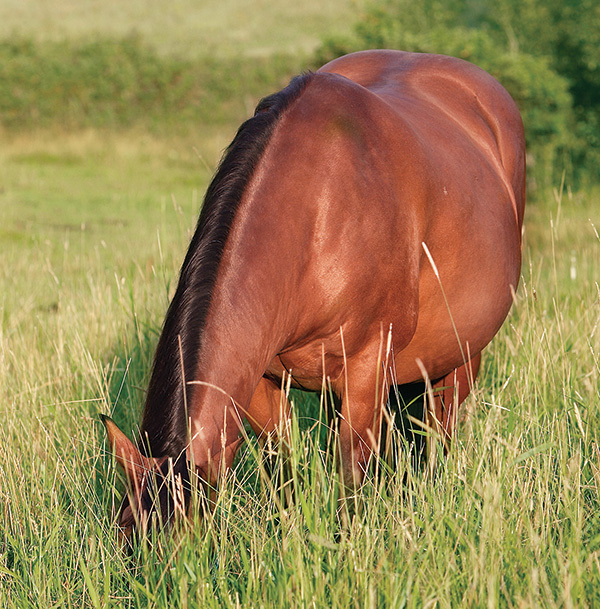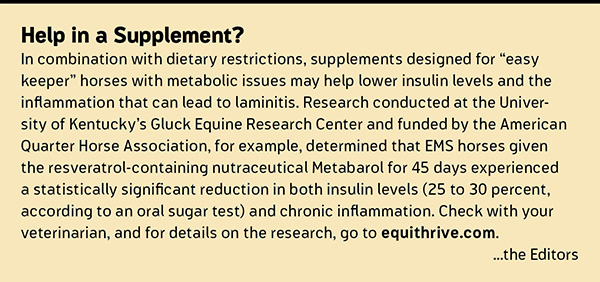Your horse is overweight and you’re worried about those metabolic issues you’ve been hearing about, especially insulin resistance. What should you know? Here, we share the latest from H&R’s consulting veterinarian, Dr. Barb Crabbe. She gives you the basics, plus tells you what to watch for and ask your vet about.

What is insulin resistance?
Insulin is a hormone released by the pancreas to help regulate blood glucose (sugar). When your horse is insulin- resistant, his tissues don’t respond adequately to circulating insulin when it’s released, causing his blood glucose to be uncontrolled.
There are two types of insulin resistance—compensated and uncompensated. In compensated IR (the more common one in horses) the pancreas responds to tissue resistance to insulin by producing more, even while the insulin already circulating isn’t being cleared by the body. This causes elevated insulin levels.
Uncompensated insulin resistance occurs when the pancreas becomes exhausted, no longer producing enough insulin to control glucose. Comparable to type-2 diabetes in humans, it’s rare in horses.
Are IR and EMS the same?
No. Insulin resistance is just one part of equine metabolic syndrome (or EMS), defined as a horse with obesity, insulin resistance, and either laminitis or high laminitis risk. You could think of EMS in three steps: obesity (risk factor), insulin resistance (the pathophysiology), and laminitis (the potential result).
So obesity is the main risk factor for IR?
Absolutely. It’s also true that ponies and some horse breeds—including Andalusians, Morgans, Paso Finos, and even some Quarter Horses—are at greater risk. Although PPID (pituitary pars intermedia dysfunction, formerly known as Cushing’s disease) and EMS are somewhat intertwined, it’s not completely clear whether PPID actually puts a horse at greater risk for insulin resistance.
How can I tell if my horse might have IR?
If your horse is obese, especially with “regional adiposity” (fat deposits in certain areas; the hallmark is the cresty neck), he’s likely to be insulin-resistant—particularly if he has shown signs of laminitis. Your vet can test his blood for resting insulin levels. (Blood should be drawn in the morning before any grain meal, and with only low-carb hay available through the prior night.) An elevated resting insulin level is meaningful, but if the numbers are normal, it doesn’t necessarily rule out IR. A more recently developed oral sugar tolerance test is more accurate for making a diagnosis. (Your vet would measure your horse’s insulin, give him sugar, wait a while, then measure his insulin again.)
What can I do to help my insulin-resistant horse?
Feed low-carb hay. Ideally, have your hay analyzed, with the goal of staying below 10-percent NSC—that is, non-structural carbohydrates, also known as starch and sugar. (For a list of testing facilities, go to foragetesting.org and click on certified labs.) If you can’t get hay that low in NSC, soaking your horse’s hay for 60 minutes in cold water can reduce its carb content by as much as 30 percent. Feed no grain, only low-starch concentrates if needed. If your horse lives out in pasture, a grazing muzzle works well to prevent overeating. Exercise is helpful on two levels: It aids with weight loss and maintenance, but also can also improve insulin sensitivity all by itself. There are also new products on the market designed to help moderate insulin levels; check with your veterinarian about these.







